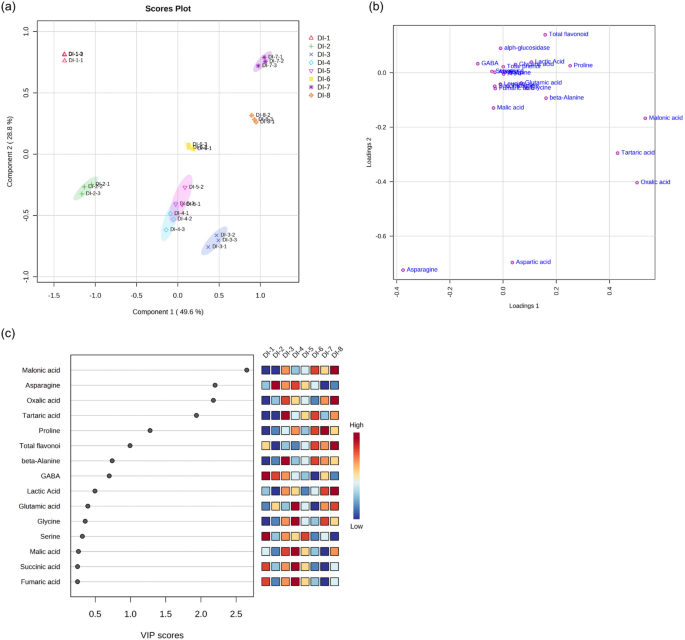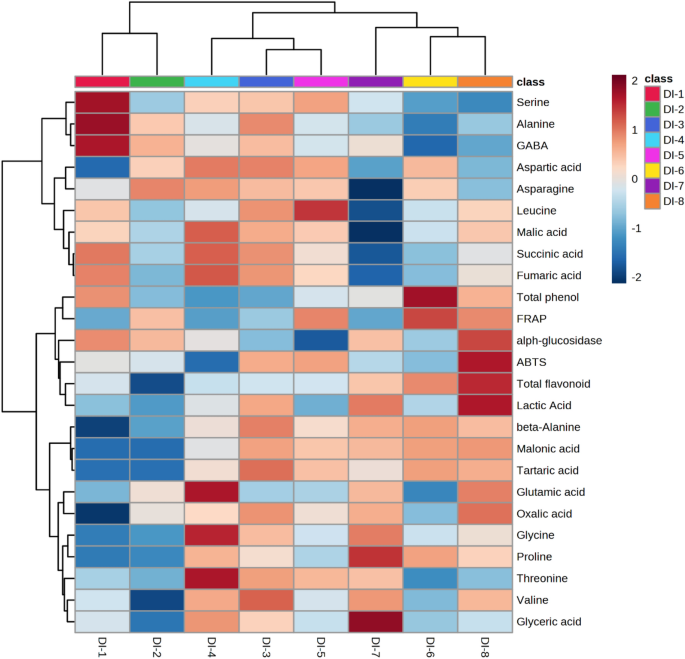Comparison of bioactive compound contents and in vitro biological activity in mixed grains with different blending ratios
In this study, the highest total phenolic content was detected in DI-6 (16.53 mg), followed by that of DI-1 (15.84 mg) and DI-8 (15.65 mg) (Table 2). The total flavonoid contents in the mixed grains ranged from 1.22 mg (DI-1) to 5.37 mg (DI-8). DI-6 and DI-8 showed relatively higher contents of bioactive compounds compared to those of other treatments. To understand the functional compound content in DI-blended samples, we analyzed the functional compound content in each individual grain (Table 3). The results showed that sorghum had the highest total polyphenolic compound and flavonoid content, with 290.18 mg GAE/g extract and 110.55 mg CE/g extract, respectively. It is likely that the high total phenolic compound and flavonoid content in our DI-blended samples were mainly due to the high total phenolic compound and flavonoid content in the sorghum. In a previous study, the total phenolic compound and flavonoid content in oats (Daeyang), sorghum (Sodamchal), adzuki bean (Arari), and proso millet (Geumsilchal) were reported as 14.37, 235.21, 15.31, and 7.92 mg GAE/g residue, respectively, and these results are considered to be at a similar level to the findings of our study33.
The results of in vitro antioxidant ability analysis are presented in Table 4. The antioxidant activities of the mixed grain extracts were remarkably affected by the blending ratio; the highest ABTS activity and reducing power were observed in DI-8 (72.05 mg TE/g) and DI-6 (0.507). Antioxidant activity is associated with antioxidant content, including phenolic compounds and flavonoids. Additionally, polyphenols, which are present in various grains, have beneficial biological effects, including antioxidant activity27. This result indicates that mixed grains, such as oats, sorghum, finger millet, adzuki bean, and proso millet, are rich sources of various polyphenols that possess an excellent antioxidant activity.
The consumption of foods enriched with active ingredients may potentially reduce oxidative damage and prevent chronic diseases, including obesity, hypertension, and diabetes3,4,5,34. Thus, this study focused on the anti-diabetic effect of mixed grains, with different blending ratios; our results showed that mixed grains are a good source of antioxidants. α-Glucosidase is an enzyme associated with the hydrolysis of carbohydrates into glucose, and analysis of its inhibitory activity is widely used to evaluate the anti-diabetic effect of different products35. Accordingly, we found that the α-glucosidase inhibitory effect of mixed grains gradually declined as the percentage of oats and sorghum decreased; the inhibition rate of DI-1 (50% oats and 50% sorghum) was 49.81%, whereas that of DI-4 and DI-3, which contain 10% and 15% less oats and sorghum than DI-1, was 41.61% and 29.96%, respectively. However, the enzyme inhibition rate was significantly increased following the addition of proso millet (DI-7 and DI-8), despite the oats and sorghum ratios being diminished. DI-8 exhibited the highest α-glucosidase inhibitory effect (54.48%). Sorghum, proso millet, and adzuki bean extracts improve type 2 diabetes by increasing glucose absorption33. Mokashi et al.36 demonstrated that flavonoids enhance the glucose uptake rate of HepG2 cells via the insulin receptor substrate 1/Phosphoinositide 3-kinase/Protein kinase B pathway. In this study, the better anti-diabetic effect of DI-8 might be due to its higher flavonoid content compared to that of the other blends. The result of this study highlight the potentiaa of the DI-8 blend as a healthy food source too prevent various chronic diseases based on its excellent antioxidant and anti-diabetic activity.
Amino acid, and organic acid profiling of mixed grains according to their blending ratios
We inbestigated the content of 12 amino acids and 8 organic acids in the mixed grains and discovered that the metabolite profile varied depending on the blending ratio. The relative values of the primary metabolites contents are presented in Table 5, and we observed significant differences (p < 0.05) in the mean contents across samples with different blending ratios.
Free amino acids have an important role in the overall taste of food products, and their content and/or composition are involved in food quality and sensory attributes37. Additionally, some nutritionally nonessential amino acids, such as glutamic acid, glycine, arginine, and proline, play important roles in antioxidative responses as well as in the prevention and treatment of metabolic diseases, including obesity and diabetes38. Among the amino acids found in the mixed grains, γ-aminobutyric acid (GABA) was predominant in the samples regardless of the blending ratio. GABA is known for its health benefits, such as its ability to regulate cardiovascular function, lower blood pressure, and improve symptoms associated with various neurological disorders39. DI-1, a blending sample composed of 50% oats and 50% sorghum, showed the highest value of GABA content, and the value gradually declined in the samples as the percentage of oats and sorghum decreased. Meanwhile, the levels of β-alanine, which is structurally similar to GABA, were relatively higher in the blending samples containing 20% adzuki bean (DI-3 and DI-6) than that of the sample containing no adzuki bean (DI-1).
Organic acids, particularly tricarboxylic acid (TCA) cycle intermediates, such as succinic acid, fumaric acid, and malic acid, are crucial for various metabolic processes such as the biosynthesis of amino acids, fatty acids, and secondary metabolites40. The quantities of organic acids present in the mixed grains varied according to the blending ratio. Malic acid was the primary organic acid in all the blending samples, with DI-4 having the highest value (370.96 µg/g) and DI-7 having the lowest (142.95 µg/g) (p < 0.05). Succinic acid was the second most abundant organic acid in the mixed grains, with DI-4 having the highest value and DI-7 having the lowest. Oxalic acid was not detected in DI-1, but its concentration increased to 9.41 µg/g in DI-3. Moreover, the mixed grains that contained proso millet, namely DI-7 and DI-8, had a relatively higher oxalic acid content than that of the other blends, except for DI-3. Although malonic acid and tartaric acid were not detected in DI-1 and DI-2, their levels increased as the ratio of adzuki bean (DI-3 and DI-6) and proso millet (DI-8) increased. Glyceric acid is an essential intermediate in the glycolytic pathway41. However, its content was lower than that of the other organic acids in all the blending samples.
Clustering and visualization of data
PLS-DA is a widely used technique in the field of chemometrics, which can be employed for predictive and descriptive modeling, and discriminative variable selection42. As depicted in Fig. 1a,b, the blending samples were clearly distinguished in the score plot obtained by combining component 1 (accounting for 49.6% of the total variance) and component 2 (accounting for 28.8% of the total variance). Variables important in projection (VIP) scores > 1 were identified as potential markers that contributed to group discrimination43. The key metabolites that differentiated the mixed blending samples based on blending ratio were malonic acid (2.6507), asparagine (2.2006), oxalic acid (2.1769), tartaric acid (1.9365), and proline (1.2787) (Fig. 1c).
Partial least squared–discriminate analysis (PLS-DA) of different metabolites in mixed grains according to their blending ratio. (a) PLS-DA score plot; (b) PLS-DA loading plot; c, variable importance in projection (VIP) scores of the top 15 metabolites.
The heatmap (Fig. 2) clearly visualizes the relationship between the mixed grains with different blending ratios, where high intensity values are shown in red. The clustering analysis grouped the blending samples into three distinct clusters: (1) DI-1 and DI-2, (2) DI-4, DI-3, and DI-5, and (3) DI-7, DI-6, and DI-8, which highlights the variation in their individual metabolite contents and biological activities. Cluster one (DI-1 and DI-2) exhibited lower amounts of lactic acid, β-alanine, malonic acid, tartaric acid, glutamic acid, oxalic acid, glycine, proline, threonine, valine, and glyceric acid compared to those in the other blending samples. Cluster two (DI-4, DI-3, and DI-5) had higher levels of aspartic acid, asparagine, malic acid, succinic acid, and fumaric acid compared to those of the other blending samples. Cluster three (DI-7, DI-6, and DI-8) showed higher amounts of β-alanine, malonic acid, and tartaric acid, and lower amounts of serine, alanine, GABA, succinic acid, and fumaric acid than those of the other blending ratios.
Hierarchical clustering and heatmap of metabolites and biological activity obtained from mixed grains according to their blending ratio. Red and blue indicate higher and lower values, respectively. The similarity measurement for clustering was based on the normalized data with Euclidean distance measurements and the Ward clustering algorithm.
DI-8 exhibited the highest levels of bioactive compounds (total phenolic and flavonoid contents) and biological activity (antioxidant activity and α-glucosidase inhibitory effect) compared to those of the other blending samples, indicating its potential health benefits. In this study, the α-glucosidase inhibitory effects of the mixed grains were positively correlated (p < 0.05) with oxalic acid, lactic acid, total flavonoid, and glutamic acid contents (data not shown). Consequently, the higher anti-diabetic activity of DI-8 be due to those compounds. However, there is a dearth of studies exploring the individual flavonoid and polyphenol profiles of mixed grains containing oats, sorghum, finger millet, adzuki bean, and proso millet. Thus, additional research on secondary metabolite profiles in mixed grains to find out the major components involved in physiological activity are needed.
- SEO Powered Content & PR Distribution. Get Amplified Today.
- PlatoData.Network Vertical Generative Ai. Empower Yourself. Access Here.
- PlatoAiStream. Web3 Intelligence. Knowledge Amplified. Access Here.
- PlatoESG. Carbon, CleanTech, Energy, Environment, Solar, Waste Management. Access Here.
- PlatoHealth. Biotech and Clinical Trials Intelligence. Access Here.
- Source: https://www.nature.com/articles/s41598-024-63660-1


